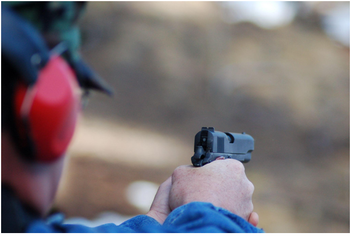Colt M1911 Not Cycling? You May Need These Colt Parts
Dec 13th 2021
The recoil-operated Colt M1911 may just be the most famous handgun ever developed. It has stood the test of time; it remained in service with the United States Armed Forces until 1985 and it remains an exceptionally popular civilian-owned pistol. Military production alone has topped 3 million, and that doesn’t even include the countless 1911-spinoffs made by Rock Island, Para-Ordnance, Ithaca, Browning, Remington, and countless others on top of the original Colts.
But the Colt M1911, despite the fact that it has remained popular, is not without the need for occasional TLC. If your Colt M1911 isn’t cycling, here are some solutions, as well as the Colt parts (or equivalents) you’ll need to address them.
A Word on Limp-Wristing
First, let’s talk about the elephant in the room. If your Colt M1911 isn’t cycling, the first potential cause you need to look straight at is the possibility of limp-wristing.
Far too many shooters have issues with this phenomenon. It occurs when a shooter does not hold a semi-automatic pistol (either recoil or gas-operated) firmly enough.
When the shooter pulls the triggers, not enough of the energy is redirected into the gun to cycle the action. When limp-wristing occurs, much of the recoil energy simply gets absorbed by the wrists and arms of the shooter, and the action will not cycle fully. This can result in failures to eject, failures to feed, and jams.
Before you look for any new Colt parts, if you’re experiencing any issues with cycling, make sure you’re firmly gripping the pistol when you’re firing it at the range. Otherwise, this bad habit can result in a variety of cycling issues.
If you can rule out limp-wristing, one of the first Colt parts you should look at is the recoil spring.
Replace the Recoil Spring
If you’re certain your form is proper and you’re not limp-wristing, and you’re using ammo that you know is loaded sufficiently to cycle the action, then the issue may lie with the recoil spring.
The recoil spring is the internal component within the slide of the M1911 that absorbs and stores recoil energy, redirecting it back into the slide after the action has opened and ejected the shell; the energy stored in the recoil spring allows the slide to travel back forward, feeding a new round into the chamber and resetting the action.
Over time, springs wear fatigue. At a certain point, your spring will age to that point that it will no longer be able to cycle the action. The prime symptom of a fatigued recoil spring is when the action of an M1911 extracts and ejects properly but fails to carry sufficient energy to feed a new round into the chamber.
Oftentimes, this will present as a slide that has closed part of the way. In some cases, the slide may have sufficient energy to strip a new round from the mag, but not to close the action all of the way.

When you replace the fatigued spring, consider adding a recoil spring guide as well. A spring guide will help to keep the recoil spring straight as it compresses, preventing kinking and other stressors. When installed, these can extend the life of your recoil springs.
Other Cycling Issues and Colt Parts Needed to Address Them:
A fatigued recoil spring is far from the only component that can cause cycling issues in a Colt M1911. These are some other fairly common problems, along with the causes and Colt parts needed to rectify the issues.
●Stovepipe Jams
Stovepipe jams occur when a round does not eject fully before the action begins to cycle close, trapping the spent shell in the ejection port. Oftentimes, the shell sticks up vertically, like a “stovepipe,” hence the name.
These jams can also be caused by limp-wristing, but if the issue is a firearm part, it is likely a failure of the ejector or ejector spring. We actually sell complete sets of Colt springs and pins here on our website that can be used to address issues associated with stovepipe jams.
●Failure to extract
If your M1911 is not extracting, the issue may be the extractor claw. However, before you replace the extractor itself, make sure you inspect the action for an accumulation of fouling. Dirt and other residue can gum up a firearm’s action, making it impossible for the extractor claw to engage the rim of the cartridge.
You may need to replace your extractor, but first, clean your pistol and see if the extraction error resolves itself.
●Failure to feed a new round
When an M1911 won’t feed, and the issue is neither limp-wristing nor the recoil spring, the likelihood is that this issue is the magazine. In place of a Colt part, you should be looking for either a new magazine or a new magazine spring. The issue may be the magazine’s follower or the internals; you can either replace these or get a new magazine altogether.
Looking for Colt parts to bring your action’s cycling back to life? Not sure what parts you need? We’re here for that.
Either give us a call at 610-250-3960 or come visit us at 50 Hilston Street in Easton, Pennsylvania and we’ll help you fix the issue.

